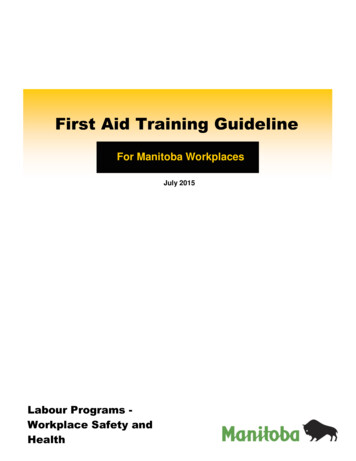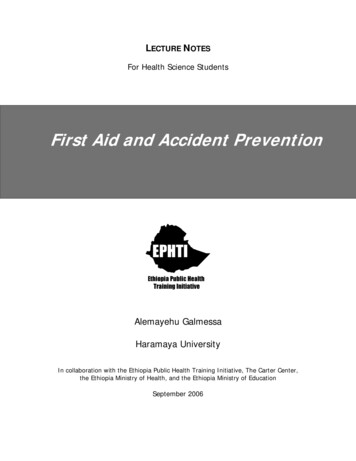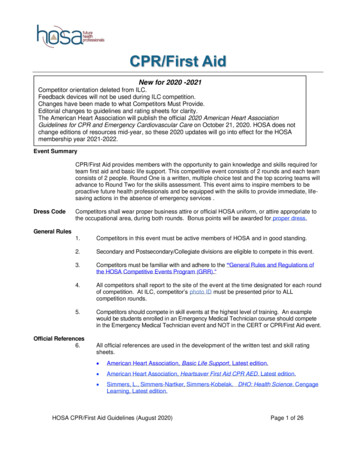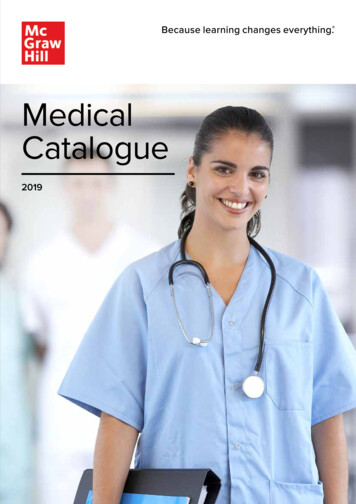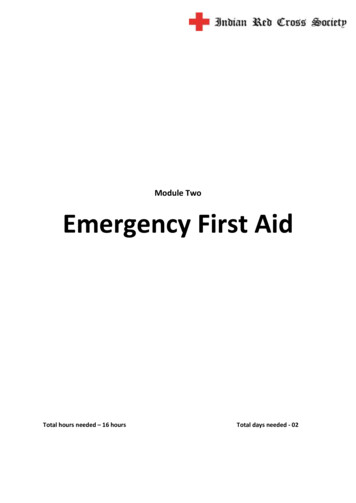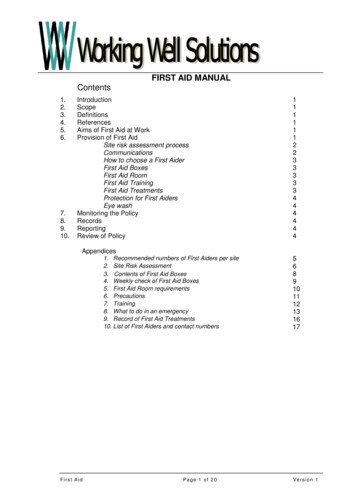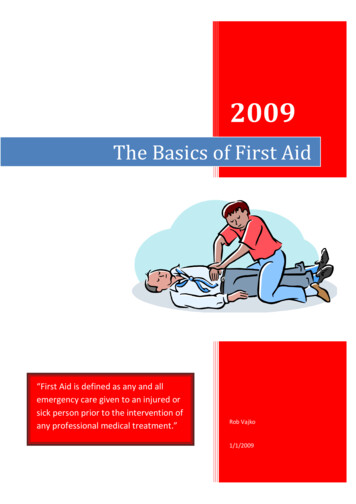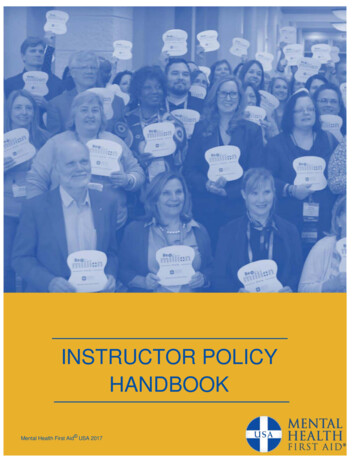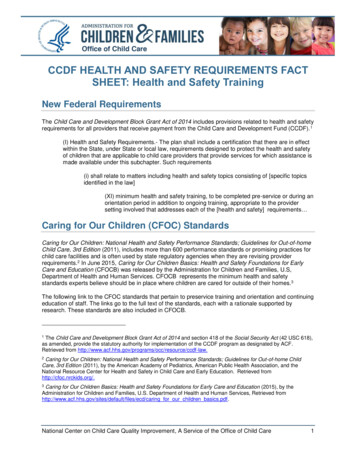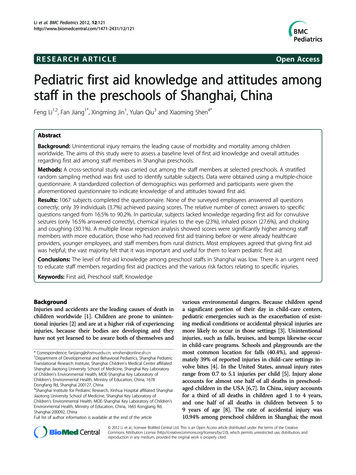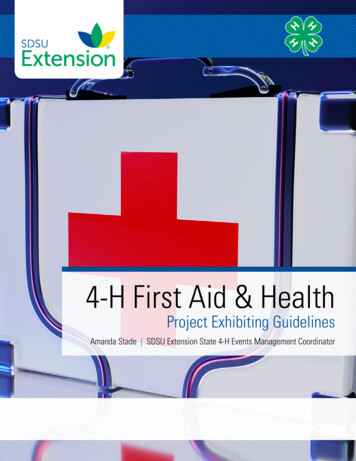
Transcription
4-H First Aid & HealthProject Exhibiting GuidelinesAmanda Stade SDSU Extension State 4-H Events Management CoordinatorPage A 2019, South Dakota Board of Regents
4-H & YouthS O U T H DA KOTA S TAT E UN I V ER S I T Y S D SU E X T EN S I O NM AY 2 0194-H First Aid & HealthProject Exhibiting GuidelinesAmanda Stade SDSU Extension State 4-H Events Management CoordinatorFirst aid knowledge and skills are essential in oursociety. Every person should be trained in first aid.Knowledge of first aid, when properly applied, maymean the difference between life and death, slow orrapid recovery, or temporary injury and permanentdisability. First aid is the immediate care given to aninjured or suddenly ill person. First aid does not takethe place of proper medical treatment. It consists onlyof furnishing temporary assistance until competentmedical care, if needed, is obtained, or until theprognosis for recovery without medical care is assured.Remember that most injuries and illnesses arecorrected with only first aid care. Developing first aidcommon sense is an important part of providing firstaid care.Through the 4-H First Aid Project, members learn basicfirst aid procedures and the important items to haveavailable during an emergency situation (first aid kit),and the best locations for making these items available.The situations and locations include, but are not limitedto, house or home; farm, to include site, buildings, ormachinery; vehicle; vehicle winter survival; sports;summer emergency survival; disaster (emergencypreparedness); or emergency pet supplies.National Poison Control Phone NumberThe National Poison Control Center phone number is1-800-222-1222.National 4-H Curriculum First Aid in Actionsling or bandaging, how to improvise in emergencysituations, how to treat burns, how to stop bleeding,how to take vital signs (temperature, pulse, andrespiration).Note: The following information about educationalposters and displays is excerpted from the State FairBook and is subject to change each year.Educational DisplayThe educational display exhibit introduces the viewerto a subject by displaying an idea or fact. The displayis not a poster; however, the educational display maybe on poster board. A display necessitates moreinformation than would be included on a poster. Theexhibit may also be three dimensional, a scale model,actual product, notebook, and so on. The exhibit maybe done in any medium (watercolor, crayon, ink, etc.).Note: Size for Educational displays is restricted to anapproximately 4’ 6’ space.Educational PosterThis exhibit presents the viewer with a design that issimple and direct, unlike a display that usually presentsmore information and uses various formats. The postermust be poster board size (14” 22”). It may be eitherhorizontal or vertical. It may be done in any medium(watercolor, crayon, ink, etc.). Design elements and artprinciples of drawings/pictures. Text and drawings mayextend to the edges of a poster for artistic purposes,but generally a well-designed 4-H poster has marginsaround all edges.Educational Posters & DisplaysGeneral InformationExhibits may include, but are not limited to: A notebookon what to do in an emergency, such as the procedurefor contacting emergency personnel, how to use aThe 4-H member’s name, ID number, address, county,and a brief interpretive statement by the memberon what they have learned and the work they havePage 1 2019, South Dakota Board of Regents
accomplished should be clearly written on or attachedto the back of each poster or display in the upperleft hand corner. The information and interpretivestatement identifies the exhibit and gives the judgeadditional information about the exhibitor.CriteriaEducational display and poster exhibits provide anopportunity for 4-H members to express views andideas learned through 4-H project work. The exhibitmust catch the viewer’s attention long enough tointroduce the viewer to a subject. The exhibit shouldillustrate one basic idea. The exhibit should impress theviewer with a specific message and arouse a response.A poster will be judged upon:PosterAttracts Attention Poster is attention getting. Arouses interest in the topic Simple and direct%20Conveys Message Expresses one basic idea Message is easy to understand Accurate and true Dynamic message, persuasive40Elements and Principles of Design Color, line, shape, form, texture Emphasis, balance, rhythm, proportion,scale, variety and unity20Originality Creative use of language, slogans Presents an original point of view Independent thought10Workmanship Poster is 14 x 22 inches Margins are used, unless there is anartistic reason for extending design toedges10A display will be judged upon:Display%Content50 Explores an idea, fact or experiment Exhibit educates the viewer Information is presented in a way that theviewer can understand Logical and sequential Information is true, accurate andcompleteDesign Presentation is displayed in anappropriate format (poster, display board,notebook, 3 dimensional model, actualproduct, etc.) Display materials are pleasing to the eye– color, line, spacing, shapes, forms30Originality Evidence of creative and independentthought, skills and work.10Workmanship Neat, readable – good grammar andpunctuation Lettering or photos/diagrams/charts areclear, readable, appropriate size.10Page 2 2019, South Dakota Board of Regents
Use of copyright/trademark with 4-H fairexhibitsA 4-H member, as an individual or member of agroup such as a judging team participating in a 4-Heducational event, may use or display with caution acopyrighted and/or trademarked product or service(e.g., a brand name, label, and/or actual product) forpurposes of developing life skills on problem solving/decision making and/or acquiring, analyzing, andusing information. The 4-H member’s intent of usingthe copyright or trademark materials for educationalpurposes such as an exhibit, educational poster/display, or youth-in-action event is acceptable underthe “Fair Use” provision. “Fair Use” is a provision of the current copyrightlaw that allows reproduction without payment orpermission of limited portions of a copyrightedwork for educational and other public interestpurposes. The 4-H member should avoid usage of copyrightand/or trademark material whenever possible byoriginating his/her own work and illustrations. A copyright and a trademark are legal methodsused by writers, artists, corporations, and othersto protect their original work. Protected items mayrange from books, to music, to computer graphics,to corporate logos. Anytime you see the letter “c” with a circle aroundit, the publisher or producer of the material holds acopyright. Similarly, all rights to use trademarks areprotected by either a trademark symbol “tm” witha circle around it or a registered symbol “r” with acircle around it. The use and inclusion of specific brand names foreducational purposes does not imply endorsementor refusal by 4-H, the Cooperative ExtensionService, or South Dakota State University. Copyrighted and/or trademarked materials utilizedin exhibits, posters, demonstrations, or otherprogram activities for endorsement, promotional,and/or selling instead of educational purposes willbe disqualified and will not receive awards.If there is a question about the appropriate use ofbrand names or labels by a 4-H member, that questionshould be resolved with a member of the appropriate4-H Youth Program Advisor before the final placing isawarded, or ideally before the educational event wasjudged.First Aid — Basic KitContents: Brand names must be visible on first aiditems for medical clarification. All contents are to beput in a container that is water resistant, durable, andlabeled “First Aid” on the outside.Inventory list of items must be attached to the insideof the lid—date items with date of purchase andexpiration date, if given (some first aid items are nolonger effective after a certain length of time, such as1–2 years).List of emergency numbers must be attached tothe inside of the lid. List to include: 911 (if availablein your local area); poison control center; emergencylocal numbers (fire, hospital, police, sheriff, emergencymedical transport ambulance). Specify names andphone numbers of your home, family doctor, familymembers, neighbors, etc. Include address anddirections to your home. If available, include cell phonenumbers, radio numbers, and e-mail addresses foremergency contacts.Includes, but not limited to the following items: Bandage scissors – Full-size, blunt-tippedbandage scissors, 5 1/2” – 6” length (strongenough to cut denim). The sharp point on a sewingscissor could scrape and/or puncture skin whenbandages, dressings, or clothing are removed. Sewing needle and tweezers to remove splintersand other objects. Small magnifying glass to enhance vision ofwound site. Safety pins to secure sling or bandage. Sterile roll of gauze bandage for coveringwounds. Sterile 4” 4” gauze pads for covering wounds. Bandages of assorted types and sizes for coveringwounds. Dish-towel sling – Purchased or hand-made andstored in a plastic bag. Clean cloth approximately36” 36” (such as a dish towel) to be used for asling or bandage. Reusable elastic wrap – 3” wide bandage forsupport or compression. Non-allergic medical tape – Approximately ½” to¾” for securing bandages. Instant cold compress to apply to decreaseswelling and/ or promote comfort. Instant hand sanitizer for cleansing.Page 3 2019, South Dakota Board of Regents
Antibacterial liquid soap for cleansing.Bottled water – For cleansing (8 to 16 oz.).Non-sterile medical gloves – In a gallon-size,sealable plastic bag. Prior to use, gloves are clean.After use, dispose of gloves in a plastic bag as aninfection barrier.Pencil or mechanical pencil and paper forrecording phone numbers, emergency information,or directions to location. (Lead pencils canhave broken lead and are thus not helpful in anemergency situation.)CPR mask or micro shield for infection barrier.CPR guidelines on small plastic card for use byCPR trained person. (Card can be purchased for 2.00 from a CPR instructor.)First aid booklet such as American MedicalAssociation, First-Aid Guide, or “First Aid Fast”from American Red Cross (Contact a pharmacy orbookstore).First Aid – Advanced KitContents: Brand names must be visible on first aiditems for medical clarification. Inventory list of itemsattached to the inside of the lid—date items with dateof purchase and expiration date, if given (some firstaid items are no longer effective after a certain lengthof time, such as 1–2 years). When preparing theAdvanced Kit, include the Basic Kit contents aslisted above. Revisions are made annually. Placethe Basic Kit contents and the following items in awater-resistant, durable container that is labeled“First Aid” on the outside: Thermometer (oral) to monitor body temperature. Antibiotic cream or ointment (any type) for minorcuts, scrapes, or burns. Cotton balls in a clean package for cleansingwounds. Flashlight (Batteries reversed to preventaccidental burnout. Label as a reminder to reversebatteries for use). HELP sign – Letters (purchased or handmade)are a minimum 4” tall ½” wide. Sign must bewaterproofed or laminated. In the event of accidental poisoning, contactthe Poison Control Center (1-800-222-1222) ora local hospital emergency room for treatmentadvice. Whistle – To signal for help.Vehicle First Aid KitContents: Kit could be used for combine, tractor, allterrain vehicle, boat, camper, etc. Brand names mustbe visible on first aid items for medical clarification.Inventory list of items attached to the inside of thelid—date items with date of purchase and expirationdate, if given (some first aid items are no longereffective after a certain length of time such as 1–2years).Place the items from the Basic and Advanced Kitsand the following items in a water-resistant durablecontainer labeled “First Aid” on the outside: Fire extinguisher. Blanket for warmth and treatment of shock. Mirror for signaling emergency help. Reflectors or flashing lights for warningoncoming traffic and/or to signal for help.Farm and Outdoor First Aid Kit ContentsBrand names must be visible on first aid items formedical clarification. Inventory list of items attachedinside the lid—date items with date of purchase andexpiration date, if given (some first aid items are nolonger effective after a certain length of time, suchas 1–2 years). Kit includes: Contents from Basic,Advanced, and Vehicle Kits, plus additional equipmentneeded for a particular situation put in a water resistantdurable container labeled “First Aid” on the outside.For information, the phone number for the NationalPoison Control Center is 1-800-222-1222.Vehicle Winter Survival KitContents: Brand names must be visible on first aiditems for medical clarification. Inventory list of itemsattached to the inside of the lid.Include these items in a water-resistant durablecontainer labeled “Winter Survival Kit” on theoutside: Three-pound metal coffee can or any metal bulkfood can with plastic cover for purposes of makinga “portable stove”— punch three holes around thetop edge of the can, so it can be hung from themirror with a sterno or candle in it. Wire for the portable stove. Candles (larger than votive) and container to holdthem. If candles are scented, use vanilla. Matches (inside a container to keep them fromgetting wet or damp).Page 4 2019, South Dakota Board of Regents
Flashlight (batteries reversed to prevent accidentalburnout. Label as a reminder to reverse batteriesfor use).Spare flashlight batteries.Canned solid fuel (i.e., Sterno).Facial tissue.Spoons, small knife, can opener and metalcups.Pencil or mechanical pencil/pad of paper.Bright red or yellow cloth for signal banner.Stocking cap, preferably with facemask.Extra mittens or gloves and socks.Instant hand warmer or instant pocket warmer– For warming hands.Rope or twine (enough to reach the trunk fromthe front door).Large plastic bags – For body-heat retention (butdo not use next to the skin).Information on winter storm survival.Non-perishable food – Suggested options: candybars (high in energy), raisins, candy, dried fruit,gum, tea bags, jar of instant coffee, soup packages(cup of soup), hot-chocolate packages, honey, beefjerky, etc.Additional information:Keep Winter Survival Kit inside the vehicle: The trunk may be jammed by collision or buried ina snowdrift. Flashlight batteries may freeze. Warm the batteries with your body—between yourlegs or under your arms.Other items to keep in vehicle: First Aid Basic and/or Advanced Kits arerecommended to have in the vehicle for wintersurvival. Windshield scraper and brush Sleeping bags Blankets Snowmobile suit/boots Booster cables Poultry grit, sand salt mix, ice-bite, or cat litter Extra metal coffee cans or metal bulk food cans –For waste. Small shovel Medications or special needs Gas treatmentSports First Aid KitContents: The following items for the Sports First AidKit need to be put in a fanny pack or a small backpack: List of emergency numbers attached tothe inside of the fanny pack to include: 911 (ifavailable in your local area); poison control center;emergency local numbers (fire, hospital, police,sheriff, emergency medical transport ambulance).Specify names and phone numbers of your home,family doctor, family member, neighbors, etc.Include address and directions to your home.If available, include cell phone numbers, radionumbers, and e-mail address for emergencycontacts. State the athlete’s birth date, includingthe year born. Bandages – Assorted types and sizes for coveringwounds. Include a large bandage. Reusable elastic wrap – 3” width bandage forsupport or compression. Pre-wrap or 3” gauze and adhesive tape (towrap and tape over so the tape does not contactthe skin). Penlight or mini flashlight for eye pupil checkand small light source. Cotton balls in a clean package for cleansingwounds. Cotton-tip swabs in a clean package to applycream or ointment. Antibiotic cream or ointment (any type) for minorcuts, scrapes, or burns. Antiseptic wipes for cleansing. Instant hand sanitizer for cleansing hands. Instant Cold Compress to apply to decreaseswelling and/or promote comfort. Pen light. Tongue depressors in a clean package forsplinting fingers or to apply antibiotic cream orointment. Non-sterile medical gloves in a gallon-size,sealable plastic bag. Prior to use, gloves are clean.After use, dispose of gloves in a plastic bag (as aninfection barrier).Summer Emergency Survival KitContents: The following items for the SummerEmergency Survival Kit need to be put in a heavy-dutybackpack: Breathing mask Red bandana to wear on headPage 5 2019, South Dakota Board of Regents
Rain ponchoWork glovesPlastic shoe coversNon-perishable food – Suggested options: candybars (high in energy), raisins, candy, dried fruit,gum, tea bags, jar of instant coffee, soup packages(cup of soup), hot chocolate packages, honey, beefjerky, etc.Water containerMetal silverwareMetal cupEmergency blanketBattery-powered radioBattery-powered, heavy-duty flashlightExtra batteries for each (radio and flashlight)First Aid – Basic Kit ContentsPlastic sheeting 10’ x 10’Roll of duct tapeSunscreen 15 SPF or higher (small bottle)Pencil or mechanical pencil and paperMoist towelettes (6)WhistleAdditional information:Not for exhibiting purposes, but should include: Personal medications Spare prescription eyeglasses Food and water for three days Waterproof matches JackknifeDisaster Kit (Emergency Preparedness)leave your home for several days, such as a severewinter storm or other emergencies? Identify thetype of kit you are organizing and include the primarypurpose of your disaster emergency kit.For exhibiting purposes, the following should not beincluded: Matches (empty box is permissible) Knife or other dangerous weapons Contact information of individuals in familyemergency communication plan. (For example,list relatives as aunt, uncle, grandparent, etc.—donot include names, phone numbers, addresses,or e-mails). Include only one sample watercontainer—the amount of water needed can belisted in your description.First Aid ReportsThe following reports will be judged using the statedcriteria:General Appearance of Report: Neat Organized Visual AppealMeets Criteria for the exhibit lot: Report in a 3-ring binder Minimum number of pages completed Report includes title page Report includes references used Optional pictures, pamphlets, or illustrationsA disaster kit must contain the materials to prepare aperson or family for emergency conditions caused by anatural (e.g., tornado, fire, or ice storm) or man-madeevent (e.g., bomb threat, chemical spill, or acts ofvandalism). Some of these events can cause the lossof electricity, water, heat, or other utilities that we takefor granted every day. Your disaster kit is meant to helpyour family in these emergencies.Written Report: Neatly typed or computer written—minimal typingor spelling errors Age-appropriate All thoughts properly and clearly developed Originality Creativity Educate the readerThe selection of materials is left to the exhibitor. Familyor group kits must have enough material or items foreach person. A description of the kit’s purpose and alist of individual contents are required.4-H First Aid Project ReportThere are different types of emergency kits: Is yours a“grab-n-go” kit that you take with you when you mustleave your home for safety reasons? Or is it a “hunkerdown” kit that is used when you or your family cannot Write a story or report on how you have used your4-H First Aid Kit (Basic, Advanced, Vehicle, Farm,Outdoor, or Winter Survival) that you have madewithin the past three years. Tell how your first aidkit contents have been used. Tell what you havelearned in the 4-H First Aid Project. Tell what youtaught or shared with others as a result of acquiredknowledge and skills.Page 6 2019, South Dakota Board of Regents
The First Aid Kit Project Report must be typed orcomputer printed and placed in a 3-ring binder.Report includes: title page, minimum 3-pagewritten report, reference page, and optionalpictures, pamphlets, or illustrations on additionalpages.Career Aspirations ReportDo you have career aspirations in health care, nursing,medicine, or health science, or do you want to be aCPR instructor or EMT? Tell of your goals and plans.Describe your presentation on first aid. How did youprepare for the workshop? How did your audienceparticipate? What visuals did you use (videotape,power point, posters, models, equipment, First AidKit, slides, computer, Internet, CD Rom, etc.). Includethe number of times presented and the number ofparticipants.May include pamphlets and handouts received. Ideas for report could include tours, visits,interviews regarding helicopter flight service, flightnursing, hospital emergency personnel, etc. The Career Aspirations Report must be typed orcomputer printed and placed in a 3-ring binder.Report includes: title page, a minimum 5-pagewritten report, reference page, and optionalpictures, pamphlets, or illustrations on additionalpages. Emergency Pet Supply KitFirst Aid Workshop Presentation ReportSuggested topics: How to use a fire extinguisher;How to treat burns; How to wash your hands forinfection control; “Thump Your Melon” from StateDepartment of Health; etc.The First Aid Workshop Presentation Report mustbe typed or computer printed and placed in 3-ringbinder. Report includes: title page, minimum 3-pagewritten report, reference page, and optional pictures,pamphlets, or illustrations on additional pages.First Aid Investigations ReportHave you interviewed a medical professional, or haveyou read stories or articles about first aid? Describe what you learned from reading aminimum of three different stories or articlesrelating to one specific first aid topic, or describewhat you saw and learned as you toured andinterviewed workers at a hospital, ambulanceservice, flight helicopter, care center, fire station,etc. Explain what effect this information has hadon your first aid knowledge and skills. The First Aid Kit Investigations Report must betyped or computer printed and placed in a 3-ringbinder. Report includes: title page, minimum3-page written report, reference page, and optionalpictures, pamphlets, or illustrations on additionalpages.This exhibit lot is cross-listed under several 4-Hproject areas and satisfies a project goal for anyof the four projects listed: Cat, Dog, Horse, or FirstAid (These kits will be judged by Vet Science judges.)In case of an emergency, your pet will still needyou to take care of it. Place all essential items in asturdy container (e.g., duffle bag, back pack, coveredplastic container, etc.) that can be carried easily. YourEmergency Pet Supply Kit should include: Pet name, pet medications and medical records,veterinarian’s name and telephone number, andowner’s name and telephone number (stored in awaterproof container). Sturdy leashes, harnesses, and/or carriers totransport pets safely and ensure that your animalcan’t escape. Current photos (stored in sealable plastic bag) ofyour pets, in case your pets get lost. List of boarding facilities, friends, or relatives thatcould provide shelter for pets Food and potable water to last three days. Bowls, cat litter/pan, can opener, or other itemsspecific to your pet. Information (stored in sealable plastic bag) onfeeding schedules, medical conditions, behaviorproblems, and the name and telephone numberof your veterinarian, in case you have to foster orboard your pets. Pet beds and toys, if easily transportable.SDSU Extension is an equal opportunity provider and employer in accordance with the nondiscrimination policies of South Dakota State University, theSouth Dakota Board of Regents and the United States Department of Agriculture.P-00109Page 7 2019, South Dakota Board of Regents
First aid knowledge and skills are essential in our society. Every person should be trained in first aid. Knowledge of first aid, when properly applied, may mean the difference between life and death, slow or rapid recovery, or temporary injury and permanent disability. First aid is the i
